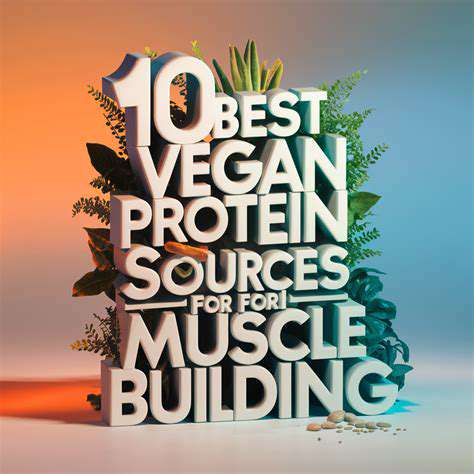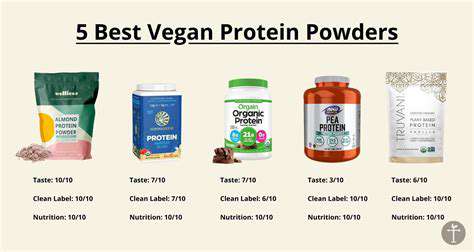Key Considerations for Muscle-Building Vegan Protein

Training Frequency and Volume
Optimizing training frequency is crucial for muscle growth. Consistent, targeted workouts are more effective than sporadic, intense sessions. A well-structured program should allow for adequate recovery between workouts, enabling the muscles to repair and rebuild stronger. Proper volume, meaning the total amount of work performed, is also vital. Increasing the volume gradually over time is essential to challenge the muscles and promote hypertrophy (muscle growth).
Training volume should be tailored to individual needs and experience levels. Beginners may benefit from fewer sets and reps with a focus on proper form and technique. Experienced lifters, on the other hand, may need to gradually increase volume and intensity to continue stimulating muscle growth. Proper rest and nutrition play a critical role in supporting the volume and frequency of training.
Progressive Overload and Variation
Progressive overload is a fundamental principle in muscle building. It involves gradually increasing the demands placed on the muscles over time, whether through increasing weight, reps, sets, or the difficulty of the exercise. This consistent challenge forces the muscles to adapt and grow stronger and larger.
Varying your workouts is also important. Introducing new exercises and rep ranges can help prevent plateaus and keep the muscles challenged. This variety also helps to target different muscle fibers and promote overall strength and size gains. Regularly switching up your routine can lead to significant improvements in muscle building results.
Nutrition and Macronutrients
A balanced diet is essential for supporting muscle growth. Sufficient protein intake is paramount for muscle repair and synthesis. The body needs enough protein to build and repair the tissues broken down during exercise. Focus on lean protein sources such as chicken, fish, eggs, and beans.
Rest and Recovery
Adequate rest and recovery are often overlooked but are critical components of a successful muscle-building plan. The body repairs and rebuilds muscle tissue during rest, not during exercise. Sufficient sleep is essential for hormonal regulation and muscle protein synthesis. Aim for 7-9 hours of quality sleep per night.
Rest periods between sets and workouts are equally important. Allowing your muscles adequate time to recover between sessions will prevent overtraining and promote optimal growth. Listening to your body and taking rest days when needed is crucial for preventing injuries.
Supplements and Considerations
While a balanced diet is generally sufficient, certain supplements can potentially aid in muscle building. Creatine, for example, is a popular supplement that can enhance energy levels during workouts, potentially leading to greater gains. However, consult with a healthcare professional before incorporating any supplements.
Consider factors like age, activity levels, and any underlying health conditions when designing a muscle-building program. Individual needs and responses to training can vary significantly. Consulting with a qualified fitness professional or registered dietitian can help you create a personalized plan that aligns with your specific goals and health status.
Supplementation and Safety
Supplementation, while potentially beneficial, should be approached cautiously. Ensure any supplements you consider are safe and sourced from reputable companies. Always consult with a healthcare professional before introducing any new supplements to your routine, especially if you have pre-existing health conditions. A balanced diet should be the foundation of your nutrition plan.
Prioritize safety throughout your muscle-building journey. Proper warm-up and cool-down routines are essential to prevent injuries. Listen to your body and don't push yourself too hard, especially in the early stages of your training. Seek professional guidance if you experience any pain or discomfort.
Top-Rated Vegan Protein Powders for Muscle Gain

Top Picks for Plant-Based Protein
Vegan protein powders have exploded in popularity, offering a delicious and convenient way to boost protein intake for those following a plant-based diet. Choosing the right one can be tricky, though, as the market is flooded with options. This guide will highlight some of the top-rated vegan protein powders, focusing on factors like taste, texture, and overall nutritional profile. These powders are designed to meet the protein needs of vegans and vegetarians alike. Many of these options are also excellent for athletes and individuals looking to build muscle or maintain a healthy weight.
When selecting a vegan protein powder, consider factors such as the source of the protein (e.g., soy, pea, brown rice, or a blend). Different sources have unique nutritional profiles and may appeal to different dietary preferences and needs. Understanding your individual protein requirements and dietary restrictions is crucial when making your choice. Reading reviews from other users can also offer valuable insights into the taste, texture, and effectiveness of various powders.
Factors to Consider When Choosing
Taste is a significant factor when it comes to incorporating any dietary supplement into your daily routine. Many vegan protein powders have a neutral or mild flavor, making them easy to blend into smoothies, shakes, or baked goods. However, some options can have a noticeable aftertaste or a gritty texture, so it's essential to consider these aspects before purchasing. Experimenting with different flavors and brands can help you find the perfect match for your palate. The texture of the powder can also vary significantly, affecting the overall drinking experience. Some powders dissolve readily, while others may leave a residue or clump together.
Beyond taste and texture, consider the protein content and the presence of any added sugars, artificial sweeteners, or other additives. Different protein sources offer various levels of essential amino acids. Ensure that the powder aligns with your dietary needs and preferences, considering any allergies or intolerances. Comparing nutritional labels and ingredient lists can help you make an informed decision about the product's overall value.
Ingredient Analysis and Nutritional Value
A key aspect of choosing a vegan protein powder is understanding the source of the protein. Pea protein, for example, is known for its high protein content and digestibility. Soy protein is another popular option that provides a complete amino acid profile, but this is often a source of controversy for some consumers. Brown rice protein is a good choice for those with allergies or sensitivities to other plant-based proteins. Ultimately, the best choice depends on your individual needs and preferences. Thorough research into the specific ingredients and nutritional value of different powders is essential. This way, you can be sure the product meets your health goals and dietary requirements.
Many vegan protein powders are fortified with essential vitamins and minerals. Pay close attention to the presence of these nutrients and their amounts, as this can significantly impact the overall nutritional value of the product. Comparing different brands and their nutrient profiles can help you identify the best option to support your specific needs. This information can help you to make a well-informed decision about the specific product and its overall value.
Maximizing Results with a Holistic Approach

Optimizing Your Approach
A holistic approach to maximizing results requires a multifaceted strategy that considers all relevant factors. This involves understanding the interconnectedness of various elements and tailoring your efforts to address the complete picture, rather than focusing solely on isolated aspects. By considering the entire system, you can identify potential synergies and leverage them to achieve superior outcomes. This comprehensive perspective allows for a more nuanced understanding of the challenges and opportunities, leading to more effective and sustainable solutions.
Understanding the Key Metrics
Successful outcome relies heavily on accurately defining and tracking key performance indicators (KPIs). These metrics provide a clear understanding of progress and areas needing improvement. Thorough analysis of these KPIs is crucial for identifying trends, patterns, and potential roadblocks. By meticulously monitoring these metrics, you can adjust your strategies in real-time and ensure that you remain on track to achieve your desired results.
A deep dive into the data can reveal actionable insights, offering a roadmap for improvement. This data-driven approach allows for a more precise and focused strategy.
Cultivating a Collaborative Environment
Collaboration is essential for maximizing results, as diverse perspectives and expertise can lead to innovative solutions. Creating a supportive and communicative environment encourages open dialogue, idea sharing, and mutual respect. Teams that work together effectively can achieve remarkable results, exceeding individual capabilities and fostering a culture of innovation. This collaborative environment also promotes a sense of shared ownership and accountability, driving everyone towards a common goal.
Adapting to Change
In today's dynamic world, adaptability is paramount. The ability to adjust strategies and tactics in response to changing circumstances is crucial for sustained success. Flexibility in approach allows you to navigate unforeseen challenges and capitalize on emerging opportunities. By embracing change and adapting to new information, you can maintain a competitive edge and stay ahead of the curve.
Embracing Continuous Improvement
Maximizing results is not a one-time event but an ongoing process. Embracing a culture of continuous improvement is essential for long-term success. Regular reviews, feedback loops, and a commitment to learning from both successes and failures are vital components of this process. By constantly evaluating and refining your methods, you can ensure that your strategies remain effective and aligned with evolving goals. This commitment to improvement allows you to stay ahead of the curve and adapt to the ever-changing landscape.